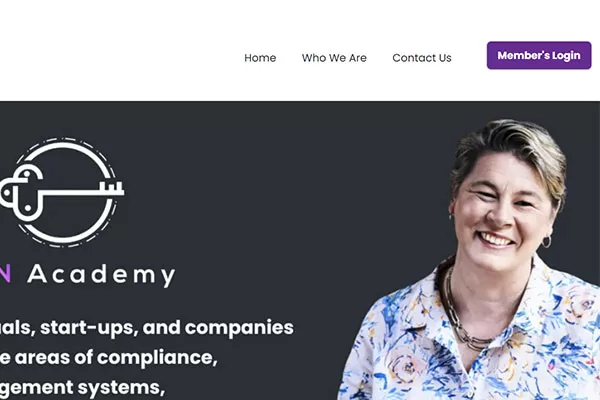For the team at QSN Academy we provide Technical On Site Search Engine Optimisation and ongoing SEO by way of content creation and reactive monitoring of Google Search Console to proactively pick up any challenges the domain faces by search engines.
Visit The Website Here
Are you a therapeutic manufacturers, a testing laboratory or associated supporting company looking to gain or maintain their GMP manufacturing license or ISO accreditation? If so, Contact QSN Academy to find out more.
What is Technical Search Engine Optimisation?
Technical on-site SEO refers to the optimization strategies implemented directly on a website to enhance its search engine visibility and improve organic traffic. While content and backlinks play crucial roles in SEO success, technical on-site SEO focuses on the structural and technical aspects of a website that affect its search engine ranking. In this discussion, we’ll delve deeper into the key components of technical on-site SEO, its importance, and best practices for implementation.
Importance of Technical On-Site SEO:
- Search Engine Crawling and Indexing: A well-optimized website structure and technical setup ensure search engine crawlers can effectively navigate and index its content. This helps search engines understand the relevance and context of each page, improving its chances of ranking for relevant queries.
- User Experience (UX): Technical optimizations often coincide with improvements in user experience. Fast loading times, mobile responsiveness, and intuitive navigation not only please search engines but also enhance user satisfaction and engagement, leading to lower bounce rates and higher conversion rates.
- Ranking Factors: Search engines consider various technical factors when determining a website’s ranking. Elements such as site speed, mobile-friendliness, SSL encryption, and structured data markup can directly influence search engine algorithms and impact a website’s visibility in search results.
- Competitive Advantage: In a crowded digital landscape, having a technically sound website can provide a competitive edge. By addressing technical issues and optimizing performance, websites can outrank competitors, attract more organic traffic, and establish authority within their niche.
Key Components of Technical On-Site SEO:
- Website Structure and Navigation:
- A clear and hierarchical website structure ensures easy navigation for both users and search engines.
- Properly organized categories, subcategories, and internal linking help distribute link equity and establish topical relevance across the site.
- Page Speed Optimization:
- Fast-loading websites are favored by both users and search engines. Factors affecting page speed include server performance, image optimization, caching, and minification of CSS and JavaScript files.
- Tools like Google’s PageSpeed Insights can help identify performance bottlenecks and provide recommendations for improvement.
- Mobile-Friendly Design:
- With the majority of internet users accessing websites via mobile devices, mobile responsiveness is critical for SEO success. Websites should adapt seamlessly to various screen sizes and provide a consistent user experience across devices.
- Google’s Mobile-Friendly Test can assess a website’s mobile compatibility and highlight any issues that need to be addressed.
- HTTPS and Website Security:
- Securing the website with HTTPS encryption not only protects user data but also signals trustworthiness to search engines. Websites without SSL certificates may be penalized in search rankings.
- Regular security audits and timely patching of vulnerabilities are essential for maintaining website security and safeguarding against potential threats.
- Structured Data Markup:
- Structured data markup, implemented using schema.org vocabulary, provides search engines with additional context about the content on a webpage. This can lead to rich snippets, knowledge graph entries, and other enhanced search results.
- Common schema markup types include product information, reviews, events, recipes, and organization details.
- Canonicalization and URL Structure:
- Canonical tags help prevent duplicate content issues by specifying the preferred version of a webpage. Proper URL structure, including descriptive keywords and logical hierarchy, aids both users and search engines in understanding the content’s relevance.
- Avoiding URL parameters, session IDs, and unnecessary parameters can simplify crawling and indexing.
- Robots.txt and XML Sitemap:
- The robots.txt file instructs search engine crawlers on which pages to crawl and which to ignore, preventing indexing of sensitive or low-value content.
- XML sitemaps provide search engines with a roadmap of a website’s structure and help ensure all relevant pages are discovered and indexed.
Best Practices for Implementation:
- Regular Site Audits: Conduct comprehensive technical audits to identify and address issues affecting website performance and search engine visibility. Tools like Screaming Frog, SEMrush, and Ahrefs can assist in this process.
- Stay Updated: Keep abreast of search engine algorithm updates, industry trends, and best practices in technical SEO. Regularly review Google’s Webmaster Guidelines and attend industry conferences and workshops to stay informed.
- Collaboration between Teams: Foster collaboration between web development, UX/UI design, content, and SEO teams to ensure technical SEO considerations are integrated into website design and development processes from the outset.
- Continuous Monitoring: Monitor key performance indicators (KPIs) such as organic traffic, keyword rankings, crawl errors, and website uptime. Implement tracking and analytics tools like Google Analytics and Google Search Console to measure the impact of technical optimizations.
- Test and Iterate: Implement changes incrementally and monitor their effects on website performance. Conduct A/B testing, user testing, and multivariate testing to identify the most effective optimization strategies and refine them over time.
In conclusion, technical on-site SEO is a fundamental aspect of a comprehensive SEO strategy, influencing a website’s visibility, usability, and overall performance in search engine results. By addressing technical issues, optimizing website structure, and adhering to best practices, businesses can enhance their online presence, attract more organic traffic, and ultimately achieve their digital marketing objectives.
